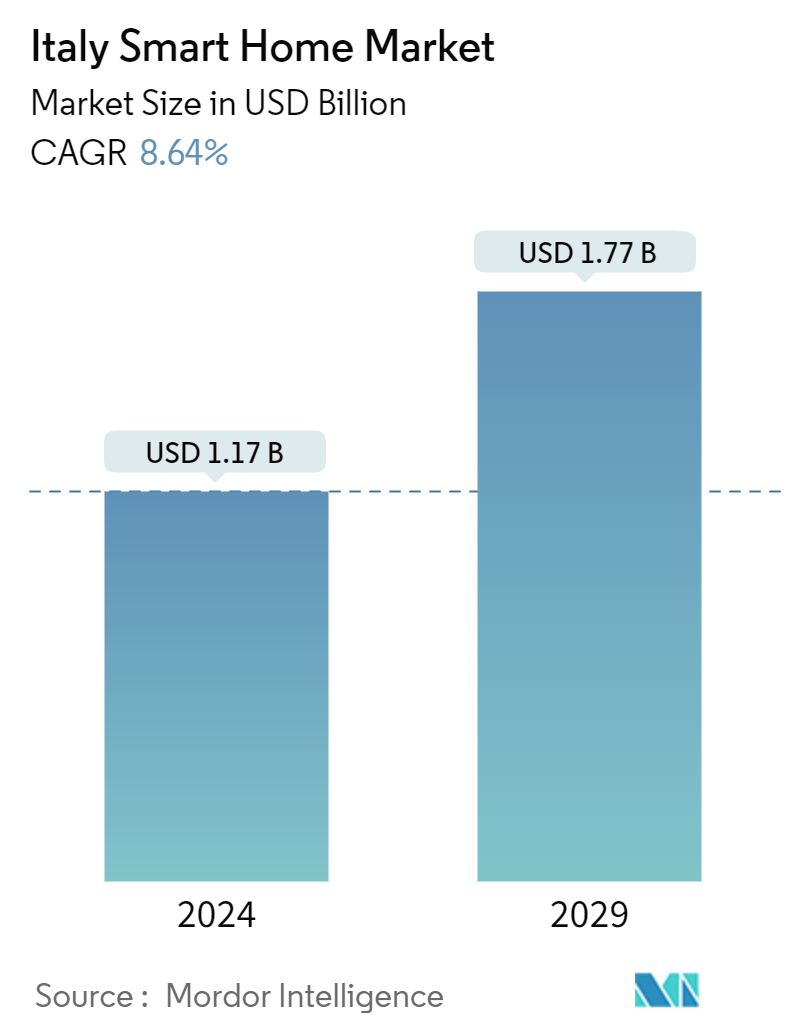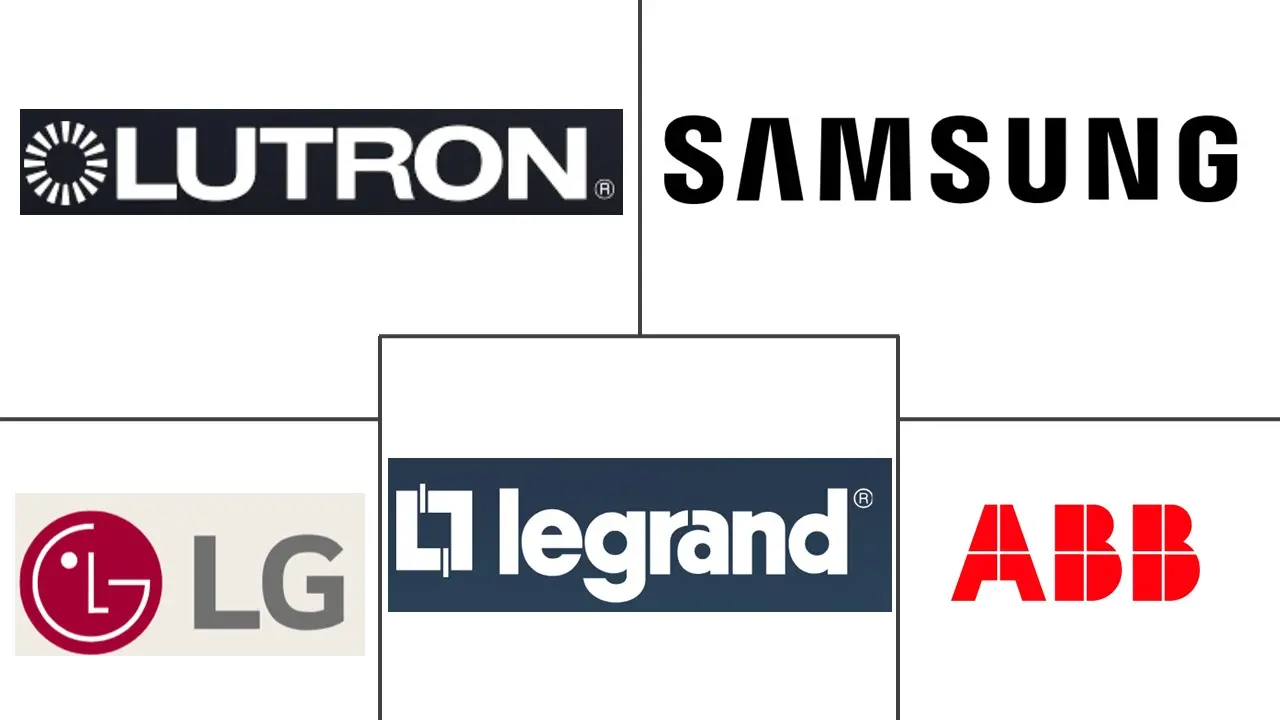Market Size of Italy Smart Home Industry

| Study Period | 2019 - 2029 |
| Base Year For Estimation | 2023 |
| Market Size (2024) | USD 1.17 Billion |
| Market Size (2029) | USD 1.77 Billion |
| CAGR (2024 - 2029) | 8.64 % |
| Market Concentration | Low |
Major Players
*Disclaimer: Major Players sorted in no particular order |
Italy Smart Home Market Analysis
The Italy Smart Home Market size is estimated at USD 1.17 billion in 2024, and is expected to reach USD 1.77 billion by 2029, growing at a CAGR of 8.64% during the forecast period (2024-2029).
- With a rising demand for smart living solutions, the smart home market in Italy is witnessing a surge in diverse, cutting-edge technologies and platforms. Considering the transformation of residential spaces in the country, home automation streamlines and elevates daily living through the seamless integration of electronic devices into homes.
- Italy experienced a surge in smart home innovations as technology progressed. The advent of smart appliances, such as thermostats, smart TVs, and connected kitchen gadgets, reshaped daily living. These devices enhanced comfort and convenience and promoted energy efficiency, bolstering the country's embrace of eco-friendly practices. By incorporating energy-saving elements, smart homes in Italy are modern and echo the nation's strong sustainability ethos.
- In addition, Italian consumers are increasingly prioritizing energy efficiency, with smart home devices emerging as critical tools for reducing annual energy consumption. Energy conservation is the primary driver propelling the sales of these devices. Notably, the surge in sales is closely tied to the adoption of connected boilers, frequently complemented by smart thermostats.
- Further, the country is actively bolstering the energy efficiency of its residential and commercial buildings, resulting in a notable drop in energy consumption. By 2030, the building sector is expected to spearhead 60% of the nation's annual energy savings. The government's proactive stance is evident through the rollout of policy tools to retrofit existing structures.
- Moreover, the country's strides in smart homes, bolstered by technological advancements, are further enriched by a growing ecosystem of startups and businesses specializing in home automation and smart technologies. These ventures foster innovation, expand product ranges, and intensify market competition. With plenty of advanced offerings, consumers are now empowered to select smart home solutions customized to their individual preferences, catalyzing the widespread embrace of smart home technologies.
- The Italian government incentivizes the adoption of energy-efficient technologies, such as smart home systems, through tax credits, rebates, and other financial perks. Italian consumers benefit from significant government tax credits, covering up to 50% of the expenses for acquiring and setting up smart home technologies. These technologies range from home automation systems and smart thermostats to energy-efficient appliances. Such incentives effectively reduce the initial financial hurdle, making smart home solutions notably more accessible.
- As smart homes become more functional and interconnected, they highlight significant ethical and privacy concerns. The data collected and analyzed from these devices can reveal intimate details about the residents, raising data protection and information security issues. Moreover, as smart homes increasingly rely on network-connected technologies, they become more susceptible to cyberattacks. This underscores the importance of implementing robust security measures to safeguard against unauthorized access and shield sensitive data.
- Further, Italy boasts one of Europe's most aged populations, with 23.5% of its residents aged 65 years or above as of 2023. This demographic trend is pivotal in propelling the adoption of smart home technologies. Elderly individuals are increasingly turning to these innovations to bolster their independence, improve accessibility, and facilitate assisted care. From voice assistants to fall detection sensors and home automation, these solutions are reshaping how seniors experience safety and comfort within their residences.
- The conflict between Russia and Ukraine is significantly disrupting the global supply chain. This disruption is acutely felt in the access control sector, with electronic components and raw materials facing both availability challenges and price escalations. Consequently, manufacturers are grappling with production delays and heightened operational costs. Rising inflation rates are driving up the costs of goods and services, notably impacting smart home products. These heightened costs are eroding purchasing power for consumers and businesses, consequently hampering market growth.
Italy Smart Home Industry Segmentation
A smart home integrates devices communicating their status through information and communication technologies (ICT) and the Internet of Things (IoT) protocols. Smart home devices oversee and regulate various home features, encompassing lighting, climate, entertainment systems, and appliances. Additionally, they can incorporate home security elements like access control and alarm systems. The study tracks different market players' revenue from selling various smart home products. It also tracks the key market parameters and underlying growth influencers that support the market estimations and growth rates during the forecast period. The study further analyzes the overall impact of macroeconomic factors on the market.
The Italian smart home market is segmented by product (comfort and lighting, control and connectivity, energy management, home entertainment, security, and smart appliances). The market sizes and forecasts are provided in terms of value (USD) for all the above segments.
| By Product | |
| Comfort and Lighting | |
| Control and Connectivity | |
| Energy Management | |
| Home Entertainment | |
| Security | |
| Smart Appliances |
Italy Smart Home Market Size Summary
The Italian smart home market is experiencing significant growth, driven by the increasing demand for smart living solutions and the integration of advanced technologies into residential spaces. This market transformation is characterized by the adoption of smart appliances and home automation systems that enhance comfort, convenience, and energy efficiency. The emphasis on sustainability and eco-friendly practices is a key factor, as consumers prioritize energy-saving solutions that align with Italy's strong environmental ethos. The government's proactive measures, including financial incentives like tax credits and rebates, further encourage the adoption of smart home technologies, making them more accessible to a broader audience. Additionally, the aging population in Italy is contributing to the market's expansion, as smart home innovations offer enhanced independence and safety for seniors.
The market landscape is marked by a dynamic ecosystem of startups and established companies specializing in smart technologies, fostering innovation and competition. The ongoing advancements in IoT, AI, and 5G connectivity are set to revolutionize the smart home experience, offering seamless automation and personalized living environments. However, the market faces challenges such as supply chain disruptions and rising costs, which impact product availability and affordability. Despite these challenges, major players are focusing on innovation and strategic partnerships to strengthen their market positions. The integration of smart energy management systems is also gaining traction, driven by rising energy costs and a growing awareness of carbon footprints. Overall, the Italian smart home market is poised for continued growth, supported by technological advancements and favorable government policies.
Italy Smart Home Market Size - Table of Contents
-
1. MARKET INSIGHTS
-
1.1 Market Overview
-
1.2 Industry Attractiveness - Porter's Five Forces Analysis
-
1.2.1 Bargaining Power of Suppliers
-
1.2.2 Bargaining Power of Buyers
-
1.2.3 Threat of New Entrants
-
1.2.4 Intensity of Competitive Rivalry
-
1.2.5 Threat of Substitute Products
-
-
1.3 An Assessment of COVID-19 Aftereffects and Macroeconomic Factors on The Market
-
1.4 Technology Snapshot
-
1.4.1 Major Communication and Connectivity Technologies Used in Smart Homes (Bluetooth, Wi-Fi, ZigBee, Z-Wave, Among Others)
-
1.4.2 Key Industry Standards and Policies
-
-
-
2. MARKET SEGMENTATION
-
2.1 By Product
-
2.1.1 Comfort and Lighting
-
2.1.2 Control and Connectivity
-
2.1.3 Energy Management
-
2.1.4 Home Entertainment
-
2.1.5 Security
-
2.1.6 Smart Appliances
-
-
Italy Smart Home Market Size FAQs
How big is the Italy Smart Home Market?
The Italy Smart Home Market size is expected to reach USD 1.17 billion in 2024 and grow at a CAGR of 8.64% to reach USD 1.77 billion by 2029.
What is the current Italy Smart Home Market size?
In 2024, the Italy Smart Home Market size is expected to reach USD 1.17 billion.

